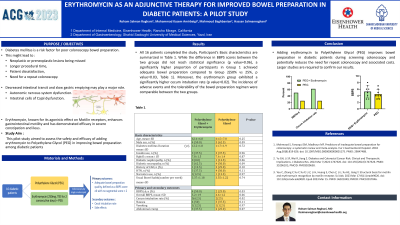Sunday Poster Session
Category: General Endoscopy
P0556 - Erythromycin as an Adjunctive Therapy for Improved Bowel Preparation in Diabetic Patients: A Pilot Study
Sunday, October 22, 2023
3:30 PM - 7:00 PM PT
Location: Exhibit Hall

Has Audio

Roham Salman Roghani, MD
Eisenhower Health
Rancho Mirage, CA
Presenting Author(s)
Roham Salman Roghani, MD1, Mohammad kazem Amirbeigy, MD2, Mahmoud Baghbanian, MD3, Hassan Salmanroghani, MD4
1Eisenhower Health, Rancho Mirage, CA; 2Shahid Sadoughi University of Medical Sciences, Yazd, Yazd, Iran; 3Shahid Sadoughi University, Yazd, Yazd, Iran; 4Shahid Sadoughi University of Medical Sciences, Blacksburg, VA
Introduction: While diabetes mellitus is a risk factor for poor colonoscopy bowel preparation, improving bowel preparation in these patients has remained an unmet challenge. Erythromycin, known for its agonistic effect on Motilin receptors, enhances gastrointestinal motility and has demonstrated efficacy in severe constipation and ileus. This pilot study aimed to assess the safety and efficacy of adding erythromycin to Polyethylene Glycol (PEG) in improving bowel preparation among diabetic patients.
Methods: This open-label, single-center pilot study enrolled 16 diabetic patients scheduled for screening colonoscopy. Exclusion criteria included a history of erythromycin allergy or the use of constipation-inducing medications. Patients were randomly assigned to two groups. Group 1 received erythromycin (250mg, 3 times daily for 2 consecutive days before colonoscopy) in addition to PEG, while Group 2 received PEG alone. Both groups received PEG as a single dose 12 hours before the colonoscopy. The procedures were performed by a single endoscopist who was blinded to the bowel preparation regimen. Bowel preparation quality was assessed using the Boston Bowel Preparation Scale (BBPS) score. The primary outcome measured was adequate bowel preparation quality, defined as a BBPS score ≥6 with no segmental score < 2. Secondary outcomes included cecal intubation rate and the occurrence of side effects. Data analysis was conducted using Mann-Whitney U test and Fisher's Exact tests, with a significance level set at P < 0.05
Results: All 16 patients completed the study. Participant’s Basic characteristics are summarized in Table 1. While the difference in BBPS scores between the two groups did not reach statistical significance(p value=0.06), a significantly higher proportion of participants in Group 1 achieved adequate bowel preparation compared to Group 2(50% vs 25%, p value=0.03, Table 1). Moreover, the erythromycin group exhibited a significantly higher cecum intubation rate (p value=0.02). The incidence of adverse events and the tolerability of the bowel preparation regimen were comparable between the two groups.
Discussion: Adding erythromycin to Polyethylene Glycol (PEG) improves bowel preparation in diabetic patients during screening colonoscopy and potentially reduces the need for repeat colonoscopy and associated costs. Larger studies are required to confirm our results.
Disclosures:
Roham Salman Roghani, MD1, Mohammad kazem Amirbeigy, MD2, Mahmoud Baghbanian, MD3, Hassan Salmanroghani, MD4. P0556 - Erythromycin as an Adjunctive Therapy for Improved Bowel Preparation in Diabetic Patients: A Pilot Study, ACG 2023 Annual Scientific Meeting Abstracts. Vancouver, BC, Canada: American College of Gastroenterology.
1Eisenhower Health, Rancho Mirage, CA; 2Shahid Sadoughi University of Medical Sciences, Yazd, Yazd, Iran; 3Shahid Sadoughi University, Yazd, Yazd, Iran; 4Shahid Sadoughi University of Medical Sciences, Blacksburg, VA
Introduction: While diabetes mellitus is a risk factor for poor colonoscopy bowel preparation, improving bowel preparation in these patients has remained an unmet challenge. Erythromycin, known for its agonistic effect on Motilin receptors, enhances gastrointestinal motility and has demonstrated efficacy in severe constipation and ileus. This pilot study aimed to assess the safety and efficacy of adding erythromycin to Polyethylene Glycol (PEG) in improving bowel preparation among diabetic patients.
Methods: This open-label, single-center pilot study enrolled 16 diabetic patients scheduled for screening colonoscopy. Exclusion criteria included a history of erythromycin allergy or the use of constipation-inducing medications. Patients were randomly assigned to two groups. Group 1 received erythromycin (250mg, 3 times daily for 2 consecutive days before colonoscopy) in addition to PEG, while Group 2 received PEG alone. Both groups received PEG as a single dose 12 hours before the colonoscopy. The procedures were performed by a single endoscopist who was blinded to the bowel preparation regimen. Bowel preparation quality was assessed using the Boston Bowel Preparation Scale (BBPS) score. The primary outcome measured was adequate bowel preparation quality, defined as a BBPS score ≥6 with no segmental score < 2. Secondary outcomes included cecal intubation rate and the occurrence of side effects. Data analysis was conducted using Mann-Whitney U test and Fisher's Exact tests, with a significance level set at P < 0.05
Results: All 16 patients completed the study. Participant’s Basic characteristics are summarized in Table 1. While the difference in BBPS scores between the two groups did not reach statistical significance(p value=0.06), a significantly higher proportion of participants in Group 1 achieved adequate bowel preparation compared to Group 2(50% vs 25%, p value=0.03, Table 1). Moreover, the erythromycin group exhibited a significantly higher cecum intubation rate (p value=0.02). The incidence of adverse events and the tolerability of the bowel preparation regimen were comparable between the two groups.
Discussion: Adding erythromycin to Polyethylene Glycol (PEG) improves bowel preparation in diabetic patients during screening colonoscopy and potentially reduces the need for repeat colonoscopy and associated costs. Larger studies are required to confirm our results.
Disclosures:
Roham Salman Roghani indicated no relevant financial relationships.
Mohammad kazem Amirbeigy indicated no relevant financial relationships.
Mahmoud Baghbanian indicated no relevant financial relationships.
Hassan Salmanroghani indicated no relevant financial relationships.
Roham Salman Roghani, MD1, Mohammad kazem Amirbeigy, MD2, Mahmoud Baghbanian, MD3, Hassan Salmanroghani, MD4. P0556 - Erythromycin as an Adjunctive Therapy for Improved Bowel Preparation in Diabetic Patients: A Pilot Study, ACG 2023 Annual Scientific Meeting Abstracts. Vancouver, BC, Canada: American College of Gastroenterology.
